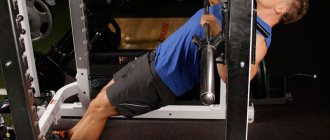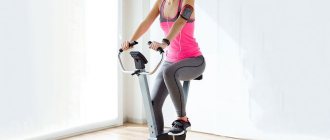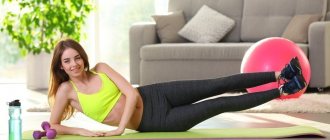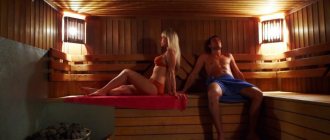Deep Squat Jump
One of the most difficult and at the same time one of the best strength exercises in the world. Such jumps strengthen the legs and upper body, and if they are used in conjunction with other exercises or interspersed with the squat-rest exercise, they will help to significantly increase the tone of all muscles. To begin, squat down, then push your legs back, leaning on your hands, quickly return to the starting position in the squat and jump sharply as high as possible.
How to make your legs strong at home?
CrossFit programs for fighters that do not require special equipment
Here are several training complexes that require only a horizontal bar and weights (optional). These programs can be used as a warm-up, a full workout, or as the final part of a main workout.
Complex No. 1
Exercise:
- 5 pull-ups
- 10 push-ups
- 15 squats
Objective: complete the maximum number of laps in 20 minutes.
How to do it:
Pull-ups are done by kipping (dirty), the main thing is that the chin goes beyond the bar. During push-ups, the chest must touch the floor, and at the top point the arms are fully straightened. When performing squats, make sure that your pelvis is below the knee line.
Complex No. 2
Exercise:
- 10 push-ups with fists
- 10 “frogs” (from crouching position to lying position and back)
- 10 sitap (press)
- 10 jumping exercises (5 on each leg)
- 10 pull-ups (kipping)
Task: complete the set number of laps without a break: 5, 10, 15, 20.
How to do it:
A mandatory requirement for push-ups is that the chest touches the floor and at the top point, the arms are fully straightened at the elbow joint. You can complicate the exercise and do push-ups with cotton. When performing the “frog”, the legs are pulled up to the arms as close as possible, and the pelvis in a crouching position is always below the knees. Abdominal exercises in this complex can be different. Conventional sit-ups can be replaced by throwing your legs behind your head, a “fold” (from a position lying on your back with your arms up, simultaneous raising of straight arms and legs with your hands touching your legs), lifting the body with twisting, etc. We do the step by jumping from a deep lunge (one leg on the knee), hands near the chin. After jumping and changing legs, lightly touch the floor with your knee. We do pull-ups “dirty”, the point is to develop explosive strength, and not to pump up certain muscles.
Complex No. 3
Exercise:
- 1 push-up
- 15 press
- 10 burpees
Task: complete 3 laps without a break.
How to do it:
Push-ups are performed on a count: from a lying position, we slowly lower ourselves to the lowest point for 5 counts (without touching the chest with the floor), a short pause and also slowly straighten our arms for 5 counts. This push-up should last 10-20 seconds. It is better to perform different abdominal exercises in this complex. For example, on the 1st circle you perform regular sit-ups, on the 2nd you do throwing your legs behind your head, on the 3rd you do a “fold”. It’s also better to do different burpees. For example, the 1st circle is “burpee”, only instead of jumping we do a two-hander in the air or a kick or knee strike, the 2nd circle is the usual one, with a jump and an overhead clap, and the 3rd circle is a “burpee” with jumping and pulling your knees to your chest in the air.
If the above complexes seem easy to you, you can always complicate them by adding more circles, increasing the time to complete them, wearing weights, or replacing the exercises with more complex ones.
Train, develop, win!
Push-ups with cotton
Another seemingly easy exercise, clapping push-ups, becomes quite difficult after two or three repetitions. Perform a push-up and, straightening your arms, instead of returning to the starting position, try to push off the floor with them so that you can clap your hands. Return to the starting position and repeat as many times as necessary. It is recommended to spend 10-12 seconds on one approach, the number of approaches is based on physical capabilities.
Push-ups with clap (instructional videos)
Neck training for wrestlers
The first rule is open your jaw, otherwise they will break it! And don't forget to put a mouthguard on your teeth: you'll still need them to celebrate your victory! Well, by the way, during a fight you should always keep your mouth closed - a good habit. It is your concentration that will allow you to fight better
In such an important matter as a fight, you should be careful and remember your technique, not forgetting to keep an eye on your opponent. This training method is suitable for people of different ages and fitness levels.
All you need to have is your own head.
First we pump the front part. To do this, lie on a bench with your back down and your neck and head hanging down, but still keep them parallel. Pressing your chin, stretch it towards your chest, and returning to the starting position, do not break the parallelism of the body. Do everything slowly - you are working for strength.
Training the rear is also effective: almost the same, but lying on your stomach. Press your chin again, pull it to your chest, return it to the starting position: your head is parallel to your body, and then leans back, while your shoulders and chest are pressed against the bench.
Well, in conclusion, work on the right and left sides of the neck. Lie on your side on the bench - your head is down, but you can’t let it hang down! First press it to your right shoulder, then return it to the starting position. Do 5 reps, switch sides. When you have pumped up your neck enough, you can weight it up to 2.5 kg by placing a weight plate on your head. This training program is good both for home and for the gym.
Wrestling master class
Have you heard of Jeff "The Snowman" Monson? Do you know how he achieved high results? He is always extremely focused on the fight. He said: “I dominate because I don’t let anyone play on my field.”
Monson performs in mixed martial arts (MMA) and in the style of Brazilian jiu-jitsu. He is famous for his north-south choke, and it is truly an exciting spectacle!
You would appreciate his ability to quickly take away an opponent's advantage by taking up all the available space and using all his weight to keep his opponent on the floor. By the way, circuit training for wrestlers helps to practice without overloading the muscles, since each new part of it goes to the group that was not in the previous one. This is how special forces are trained.
Monson admits that Russia is like a second home for him, because it is here that he is greeted like a brother and he likes to be here. Jeff has visited our country seven times already
Watching his performances is a pleasure! Search the Internet for “Jeff Monson wrestling” and watch his video! The fact is that he is a very concentrated fighter and pays attention to neck training. The athlete remembers many of his opponents' techniques! In battles, it is important to predict the enemy’s intentions and next steps, so a true pro is always several points ahead with his mind! Monson shows wrestling techniques on the ground: when your partner is lying on the floor
For strikes you will definitely need . This can be very useful for you, because he was once a simple person, and not a famous athlete. It is the use of the entire arsenal of skills that allows you to become a champion!
Pull-ups
Pull-ups are one of the most useful exercises in the general strength training of a judo wrestler. The ability to pull your chin above the bar strengthens your entire body, which is an important factor in gaining an advantage over your opponent. Whether you use a close, wide, or medium grip, making pull-ups a regular part of your workout routine will significantly strengthen your back muscles, making it easier to keep your opponent off balance during grappling.
How to learn to do pull-ups from scratch? All assistance exercises, all types of pull-ups.
Exercises for circuit training in martial arts
Exercises for circuit training allow you to develop strength, speed and endurance not individually, but in combination, thereby increasing strength endurance, speed-strength endurance and speed strength
What is the purpose of circuit training exercises?
Circuit training exercises aim to involve all muscle groups and functional systems of the body to prepare the athlete for the real conditions of competitive performances.
The method of circuit training for martial arts athletes turned out to be especially effective, since diverse and non-cyclical activity causes the body to experience a severe stressful state, in which an unprepared body will very quickly use up all its resources. As training increases, exercises for circuit training should be as close as possible to special exercises in terms of the method of execution and the nature of the efforts developed, influencing the athlete’s muscle groups involved in the technique of movements during a fight: shoulder girdle, legs, body, back, arms.
When systematically training martial arts athletes, it is recommended to select cycles of circuit training, having previously conducted tests to assess general readiness and periodically taking control measurements upon completion of the stages of the cycle. Circuit training exercises, selected individually for each athlete, give the greatest effect. Measuring indicators during the cycle allows you to adjust the methodology itself to increase its effectiveness
Let's consider exercises for circuit training of boxers , adopted in sports institutions of the USSR, and which have shown their effectiveness with a huge number of victories for our athletes in international arenas
Main stations
1.Jumping over a bench
Purpose: strengthening the calf muscles, foot ligaments.
Effect: maintaining balance when landing, makes it possible to quickly orient and assume a combat position after moving, attacking or counterattacking.
2. Direct blows with resistance
Purpose: development of explosive arm strength
Effect: allows you to develop the ability of muscles to quickly relax after a sharp and strong contraction. You can use exercise machines or tourniquets, expanders
3. Twisting the torso from a lying position
Purpose: strengthening the abdominal muscles, mobility and flexibility of the spine in the lumbar region.
Effect: a sharp transition of the abdominal muscles from relaxation to tension increases resistance to shock. The twist is performed with a sharp exhalation in the final position.
4. Throwing the bar forward while standing
Purpose: development of explosive strength and speed of work of the muscles of the arms, upper shoulder girdle and back.
Effect: the exercise is distinguished by distinct muscle-motor sensations. The barbell is held with your fingers at chest level. An initial powerful volitional and muscular tension, an explosion, is required. 5. Depth jumps (jumping on a bench + shadow boxing)
Jumping on a cabinet
Purpose: development of explosive strength of the leg muscles.
Effect: The moment of repulsion after landing is key. The time of contact of the feet with the floor should be minimal, and the height of the jump after take-off should be maximum.
6. Push the medicine ball forward from the shoulder into the wall
Purpose: development of explosive strength and speed of work of the back, pelvis, leg muscles, arms, upper shoulder girdle, and improvement of their coordination relationships.
Effect: The pushing technique should be as close as possible to the technique of delivering a direct blow. The exercise also develops the ability to instantly transition from tension to relaxation, and vice versa.
7. Somersaults
Purpose: an effective means of increasing the vestibular stability of athletes
Effect: improved ability to maintain stable dynamic balance
8. Push the barbell forward with your hand
Purpose: development of strength endurance of the arms, muscles of the lateral surface of the body.
Effect: Increases the power of the blow. The exercise should be performed in the starting position of a boxing stance, for both the left and right hands. The key is the initial powerful acceleration, the movement begins without swinging.
9. Jumping over a goat
Purpose: improving coordination of movements
Effect: development of the ability to accurately measure movements according to their strength, speed, direction, amplitude. The unusual position of the body in space and the speed of its change when jumping contributes to quick orientation in combat conditions
10. Hammer strikes on a tire
Purpose: strengthening muscles, increasing impact force
Effect: under the influence of percussive movements, the muscles become elastic, the mobility of the arm joints improves, the wrists become stronger, and the strength of the hand increases. The blow is combined with a sharp exhalation, and therefore with the movement of the respiratory muscles, which helps regulate the boxer's breathing, and also improves the ability to concentrate efforts at the moment of the blow
Video of circuit training for boxers in the USSR
To optimize the load level, after every three minutes of pure work on apparatus, a one-minute break is given to measure the trainee’s pulse rate. At optimal load, the heart rate should correspond to 120-140 beats per minute after three minutes of work. 160-180 beats after 6 minutes. 200-220 beats per minute after 9 minutes of exercise. If the heart rate does not meet the requirements, load optimization is performed.
The time of work at the station, and the time of rest, depends on the stage of the preparation cycle. In the general preparatory period, the work time at stations can be 3 minutes, and rest intervals can be 1 minute. As fitness increases, the intensity of exercise increases, and the time of rest and work decreases.
An example of circuit training for martial arts athletes of the TARGET martial arts club
Rope climbing
Climbing a pole or rope is another very useful exercise for judokas. Rope climbing is used by all high-level judo fighters, as this exercise not only strengthens the arms, back and whole body, but also increases the production of lactic acid in the forearms and hands. This important factor makes itself felt in the last minutes of the fight. If you regularly perform pull-ups on the rope week after week, you will not only be able to give yourself an advantage over your opponent in your choice of grip, but you will also be able to hold on to your chosen grip for much longer.
How to learn to climb a rope
Workout in the gym
Tip 1: Barbell Squats
Performing both deep and fast squats—as shown in a 2002 study in the Journal of Strength and Conditioning Research—helps build muscle and strength in your legs and hips When squatting with weights, move your hips back slightly before bending your knees. Keep your shins nearly vertical throughout the lift. When rising from the bottom of a squat, moving your head back and lifting the barbell quickly is the best way to develop leg strength.
Tip 2: Deadlift
Perform deadlifts according to all the rules, lifting the barbell off the floor each time. Don't let the bar bounce off the floor during reps. To better develop leg strength, use a sumo stance, where your feet are wider than shoulder-width apart and your hands on the barbell are between your legs. Push your knees outward so your shins are closer to vertical, then lift the barbell off the floor using the strength of your legs. It puts more stress on the legs and hips and less on the back than a conventional deadlift (according to a 2002 study published in the journal Medicine and Science in Sports and Exercise).
Tip 3. Bench press with a barbell
Perform bench presses, pausing each rep as you lower the bar to your chest. This is required in powerlifting competitions and it builds explosive power for throwing. Perform the bench press with a full range of motion to ensure your triceps are working well. Triceps strength is extremely important in all types of arm movements because the triceps, or the muscles at the back of the shoulder, are involved in the rapid extension of the arm.
Tip 4. Number of classes
Train in the gym no more than three days a week to give yourself time to recover before practicing judo on the mat. Focus on the squat one day, the bench press another, and the deadlift the third. You need to evaluate your ability to recover before making changes to your training program. If you have enough energy and fatigue does not limit your group activities, you can increase the volume of your training. If you're struggling with pain after lifting weights, it may be worth reducing your training volume until you get into better shape.
Tip 5. Range of motion
Work with additional weight, performing all exercises with a full range of motion. While many weightlifters perform partial range of motion movements, your training should maintain your judoka form. Each throw or grab may require a full range of motion, and this is what you need to develop. Perform full range of triceps stretches with a barbell or dumbbells to improve your bench press. Do additional hamstring exercises, such as hip curls and reverse hyperextensions, to improve your squat and deadlift. Adjust your training volume according to your ability to recover.
Stretching/contracting the elastic band
Judokas constantly tense and contract the muscles of the forearm and wrist, as a result of which many of them develop a so-called muscle imbalance in the forearms. This can lead to injuries, sprains and inflammation of the tendons. Stretching the band gradually strengthens the opposing muscles (wrist and forearm extensor muscles), which is important for creating muscle balance. Just wrap the elastic around your hands and start stretching and tightening it again. Repeat this movement at least fifty times a day for the first week, gradually increasing the number of sets.
Unique projectile
You won't do this with a sandbag either. This projectile is “unfriendly” and unpredictable. It requires the activation of every muscle fiber to lift and hold it. There is no special position of the arms or legs, since the sandbag constantly changes its center of gravity. Because of this “harmful” behavior of the bag, you strengthen your core - core. The core muscles have to work harder and harder to stabilize the body under the changing load of the sandbag.
Another benefit of sandbags is training your grip strength. There isn't a fighter in the world who wouldn't benefit from more grip. Grip strength in MMA, wrestling, grappling and other martial arts is the basis for success in a fight. And you can develop your grip in any exercise with a bag - the constant movement of sand in a sandbag under the influence of gravity and inertia develops not only tenacity of the fingers, but strengthens the muscles of the wrist and forearm.
All the basic strength exercises that you used to do with iron can now be done with a sandbag. It would be even better to combine exercises with different equipment in a wrestler’s training.
Here are some great moves selected by the MONKO team for sandbag training.
Sandbag wrestler training program:
- clean and jerk; snatch; push; Turkish get up;; deadlift; squats; swings; shoulder take.
Of course, there are a lot more exercises. The variety of movements is limited only by your imagination. In our gym, we sometimes even play sandbag rugby.
Strengthening the core - Plank exercise
This exercise has many names, but very often it is performed incorrectly. To perform it correctly, you need to take a push-up position, but you need to lean not on your hands, but on your forearms. Your thighs should be parallel to the floor, and you should not rise too high or lower yourself to the floor. Concentrating on the abdominal and lower back muscles, slowly squeeze your shoulder blades together. Hold this position for the required time. If the exercise seems simple to you, begin to slowly raise your arm and leg. This will force your entire core to tense up while maintaining your balance.
Plank exercise - execution technique
Complex 2
• 10 deadlift
• 20 kettlebell snatches (10+10)
• 80 m “bear walk”
Challenge: 5 laps in minimum time
How to do it:
When doing deadlifts, we make sure to do it correctly so as not to injure your back.
We do 10 kettlebell snatches on each arm, without alternating. It's better to start with a weak one. The weight is not placed on the floor in the lower position, but is thrown up above the head by inertia due to the legs and back.
“Bear gait” - moving on 4 limbs. This exercise helps strengthen the abductor muscles of the hips, arms and abs. In this complex, this particular exercise should become a kind of rest for you before the next round.










